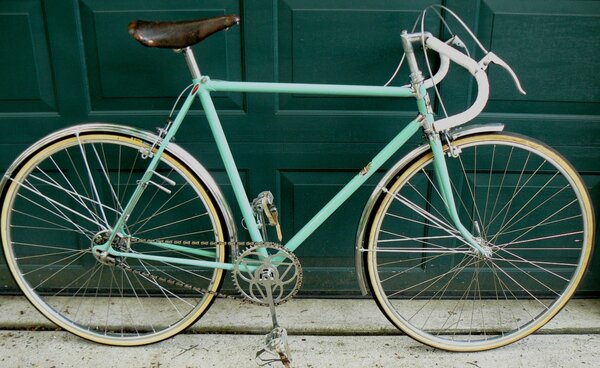You are using an out of date browser. It may not display this or other websites correctly.
You should upgrade or use an alternative browser.
You should upgrade or use an alternative browser.
Paris-Roubaix equipped Fossati frame from 1949-50
- Thread starter Citoyen du monde
- Start date
Citoyen du monde
rBotM Winner
keithglos":33j50kpw said:C d M, What a classy example, it makes the best the big makers did look poor at best. And Bianchi were very heavy.
The fortunate racer who had this bike probably needed mudguards for training.
I last rode my P/R gear in an open road race in 1956. I had 14 - 24 with 48 x 51 on the front. No problem with the chain length in exreme gears, and used a Campagnolo H/B control to allow undoing the wheel, but pedalling forward to change the front. There is a neat adjustible cam and ratchet to move the wheel slightly forward as the QR tightens, to make sure the chain is not tight. The real problem with these and "Osgears" was the chain runs much better if fed onto the cogs in line. (apart from the obvious)
I could be wrong, but the front hub might have the alternate countersinks for the spoke holes, which were intended to suppport the bend, not hide the spoke head. European wheels were mostly built with the inside spokes in opposite directions, in this case it may be that the angle and stagger did not allow this.
Keith,
While I agree that the workmanship of this frame is superlative, I have also owned a number of Bianchi bikes that were also of very high production quality. Most were indeed heavier than this bike, but not all. In particular I have a Bianchi Folgore from 1941 that was built with Mannesmann Extra tubing, which long held the primacy as the lightest bicycle tubing available in Italy.
As regards the countersinking of the spoke holes in the hub flanges, they are identical for all, so there is no specified building pattern. Because the hub is a three piece hub, it is also possible to place the hubs in any position you want, so there should never be a problem getting the holes lined up the way you want.
Attachments
Citoyen du monde
rBotM Winner
SWijland":1fc2kqsf said:Very very cool! Never seen a bike before with the Campy Paris-Roubaix derailleur.
Als je ooit in de beurt van Philadelphia bent, mag je ook rustig een proefrit maken.
D
Deleted member 24574
That is fantastic. How did the chain tension change on gear shift?
As possibly the only person left alive to have used one in an open road race, the rear wheel quick release has an extended lever, to undo the rear wheel. As this is turned it locks on to the changing fork, you select alternative gear by back pedalling, then lock up the Q/R, which adjusts the chain tension as previously described. The rear ends have a rack of teeth under the upper surface, and the rear axle has the mating teeth, this keeps the wheel straight. In addition, I used to operate the front changer from a handlebar control, but of course pedalling forwards. The wheel would not fall out because it could touch the bridge behind the bottom bracket, and roll back in.
It was superceded by the Simplex "Tour de France" for most professionals, then the Campagnolo parallelogram.
Hope this helps.
It was superceded by the Simplex "Tour de France" for most professionals, then the Campagnolo parallelogram.
Hope this helps.
Citoyen du monde
rBotM Winner
Montello":y9cruxnq said:That is fantastic. How did the chain tension change on gear shift?
Gravity handles most of it.
dirttorpedo
Senior Retro Guru
Wonderful bikes. Thanks for sharing.
- Feedback
- View
That is a real thing of beauty.
Old road bikes are a bit of a mystery to me, but I can still appreciate the aesthetic.
Old road bikes are a bit of a mystery to me, but I can still appreciate the aesthetic.
